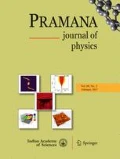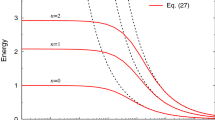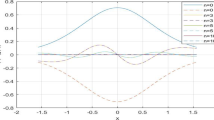Abstract
In this paper, we construct isospectral Hamiltonians without shape-invariant potentials for the relativistic quantum mechanical potentials such as the Dirac oscillator and hydrogen-like atom.
Similar content being viewed by others
1 Introduction
The discovery of the new orthogonal polynomials, known as exceptional polynomials, in the last decade by David Gómez-Ullate et al [1, 2], has given rise to a lot of new exactly solvable potentials. These new potentials are known as rational extensions. The old and the new potentials are related by an intertwining operator of the supersymmetric quantum mechanics. These new potentials give rise to a rich structure, with one of the states missing between the old and the new Hamiltonians. This excluded state, in turn, is reflected in the solution as one of the degrees missing in the polynomial sequence. In literature, the missing degrees in the polynomial sequence are termed as codimension of the exceptional family. It is well known in the literature that these rational extensions are related through Darboux transformations. First such potential of codimension-2 is constructed by Quesne [3, 4], and the potential for any arbitrary codimension is given by Odake and Sasaki [5, 6]. Exceptional orthogonal families with higher-order are generated through Darboux transformations [7,8,9]. The role of Darboux transformations is further studied and clarified in ref. [10]. Exceptional polynomials are developed using the prepotential approach [11]. The exceptional polynomials are also extended to PT symmetry Hamiltonians [12] and the prominent examples being PT-symmetric Scarf II potential [13,14,15]. Exceptional polynomials for symmetry group preserving the form of Rayleigh–Schrödinger equation are constructed [16]. An alternative derivation of many infinitely exceptional Wilson and Askey-Wilson polynomials is presented in ref. [17]. These exceptional polynomial systems appear as solutions to the quantum mechanical problems in the exactly solvable models [18, 19] or in superintegrable systems [20]. In ref. [21], it is shown that quantum mechanical problems whose solutions are Laguerre or Jacobi polynomials will also admit exceptional Laguerre or Jacobi polynomial solutions after a suitable modification of potential. One of the authors has constructed exceptional isospectral Hamiltonians for the harmonic oscillator Wigner function [22]. Exceptional Laguerre polynomials and the corresponding rational potentials are obtained using quantum Hamilton Jacobi approach [23]. In all the previous cases, the energy of the particles is less than their rest mass energy but when the energy of particles is greater than their rest mass energy, then relativistic effects become important. Then, these particles are studied under relativistic quantum mechanics. Study of subatomic particles, moving at relativistic speeds, is incomplete without unifying quantum mechanics with relativity. Properties of the Dirac oscillator potential are studied by Benitez et al [24]. It is found that the energy eigenfunctions are the same as the non-relativistic harmonic oscillator [25]. In ref. [26], a canonical quantisation was done on the Dirac oscillator in \((1+1)\) and \((1+3)\) dimensions where it was found that Dirac oscillator field can be identified to be composed of infinite degrees of freedom that are decoupled quantum linear harmonic oscillators. It is shown that the energies of relativistic linear harmonic oscillators for the Dirac oscillator field are the quanta. In ref. [27], the partition function and other thermal properties like free energy, entropy, and specific heat are calculated for the \((1+1)\)-dimensional Dirac oscillator, with spin non-commutativity of coordinates.
In this paper, we construct rational extensions to the Dirac equation in the presence of Hartmann and ring-shaped potentials, the solutions of which are the exceptional Laguerre and exceptional Jacobi polynomials. Then we extend our procedure to construct rational extensions for the radial component of the Dirac oscillator subjected to the combination of Aharnov–Bohm and magnetic monopole potentials. The solutions turn out to be exceptional Laguerre polynomials. Finally, we construct rational extensions for the relativistic hydrogen-like atom and arrive at solutions that are exceptional Laguerre polynomials.
This paper is arranged as follows: In §2, we consider the Dirac equation in the presence of Hartmann and ring-shaped potentials. In §3, we solve the radial component of the Dirac oscillator wherein the electromagnetic potential is the combination of the Aharnov–Bohm and magnetic monopole potential. After making suitable modifications to the equation, we obtain the form of the Laguerre differential equation and the isospectral potential. In §4, we derive isospectral potential for relativistic hydrogen-like atom and show that the solutions are exceptional Laguerre polynomials. In §5, we make brief concluding remarks.
2 Exceptional polynomial solutions for the radial part of the Hartmann and ring-shaped potentials
In this section, we construct the exceptional Laguerre polynomials as solutions to the Dirac equation in the presence of Hartmann and ring-shaped potentials. Hartmann’s potential is a non-central potential introduced by Hartmann [30] obtained by adding a potential to the Coulomb potential. Ring-shaped oscillator potential is that obtained when the Coulomb part of the Hartmann potential is replaced by the harmonic oscillator term used to describe its energy spectrum [30]. We consider the radial component of the Dirac equation in the presence of Hartmann and ring-shaped potentials that is derived by Bakhshi [28].
By following the procedure in [28] and defining
then substituting in eq. (1) in terms of natural units we get
The solution to eq. (2) as taken in ref. [28] is
where \(\xi =\frac{1}{2}\omega r^2\) gives the Laguerre differential equation and \(L_n(\xi )\) satisfies
To derive exceptional Laguerre polynomials as solutions to the Dirac equation in the presence of Hartmann and ring-shaped potentials, we add an extra potential \(V_e\) to the differential equation (4).
Here we define \(l+\frac{1}{2}=m \) and \(n=\lambda -1\). We demand that
be the solution to eq. (5). Then we get
On rearranging
On comparing eq. (10) with the standard form of \(X_1\)-Laguerre equation (11),
and demanding \(f_n(\xi )\) to satisfy the \(X_1\)-exceptional Laguerre equation determines the potential \(V_e(\xi ,m)\) to be
Substituting back \(m= l+\frac{1}{2}\) and \(\xi =\frac{1}{2}\omega r^2\) we obtain the exceptional partner potential as
We have to add these terms to the original potential in order to get the exceptional partner potential \(V^+(r,l)=V_o(r,l)+V_e(r,l)\). Hence, we obtain the modified form of the partner potential as
Thus, by changing the weight function of the Laguerre polynomial, we arrive at an isospectral potential to the Hartmann and ring-shaped potentials.
Exceptional polynomial solutions for the angular part of the Hartmann and ring-shaped potentials
In this section, we shall proceed to consider the angular part of the ring-shaped potentials as given by the first function in the differential equation from ref. [28]
substituting
as done in ref. [28].
Taking
Taking the solution for eq. (17) to be
we obtain
Here \(\alpha =-\lambda +s-\frac{1}{2}\); \(\beta =\lambda +s-\frac{1}{2}\) and \(P_n^{(\alpha , \beta )}(\cos \theta )\) represents the Jacobi polynomial. On suitable modification of the weight function of the Jacobi equation, we can get the extra terms of the exceptional potential.
The exceptional Jacobi differential equation is given by
Now adding an extra potential term, \(V_e\), to eq. (19) we have
Here
We demand
to be the solution of eq. (21). (The calculations of \({\mathrm {d}H_n^{(\alpha , \beta )}}/{\mathrm {d}\cos \theta }\) and \({\mathrm {d}^2H_n^{(\alpha , \beta )}}/{\mathrm {d}\cos \theta ^2}\) are provided in Appendix 1.)
Substituting the values in eq. (21), we have
After a bit of algebra,
(The derivation of exceptional form of the Jacobi differential equation is provided in Appendix 2.) Taking
This is the form of exceptional Jacobi differential equation, given by eq. (20). Comparing this with the standard form we get the extra terms of the exceptional potential \( V_e\). This determines the exceptional potential term \(V_e(\cos \theta )\) to be
After a few algebraic modifications we get
Hence the total superpotential is given by \(V(\cos \theta )=V_o(\cos \theta )+V_e(\cos \theta ).\)
Similarly, we can find the exceptional Jacobi solutions to the second function of ref. [28]. If
the solution satisfies the equation
Now adding an extra potential term \(V_e(\cos \theta )\) to the above equation gives
\(a= \dfrac{s-\lambda }{2}\); \(b=\dfrac{s+\lambda -1}{s-\lambda }\); \(c=\dfrac{s+\lambda +1}{s-\lambda }.\)
Now setting
and demanding that \(f(\cos \theta )\) satisfies the exceptional Jacobi differential equation
and solving on similar lines, the exceptional potential for the exceptional Jacobi differential equation can be shown to be
The complete isospectral potential is given by
3 Exceptional polynomial solutions for the Dirac oscillator in the presence of Aharnov–Bohm and magnetic monopole potentials
Aharnov–Bohm effect is a quantum mechanical phenomenon in which a charged particle, though confined to a region of no electric and magnetic fields, is influenced by an electromagnetic potential. The three-dimensional Dirac equation in the presence of Aharnov–Bohm and magnetic monopole potentials is studied by Alhaidhari, and exact solutions to the Dirac oscillator are obtained, vanishing the time component in the electromagnetic potential [29]. The three-dimensional Dirac equation is given by
where m is the mass of the rest particle. Here we consider natural units and the radial part of the Dirac oscillator for positive energies is given by
For the Dirac oscillator problem, we take W(r) to be linear in radial coordinate as \(W =\omega ^2r\), where the real parameter \(\omega \) is the oscillator frequency. Thus, we have
By choosing
going over the natural units, that is \(\omega =1\), eq. (35) resembles non-relativistic 3D oscillator. Taking \(R(r)= r^{l{+}1}\exp ({-}r^2/2)\) as solution for the differential equation (35), we have
By making a change of variable \(r^2= \xi \), we arrive at the Laguerre form of differential equation,
where \(L_n^k(\xi )\) satisfies Laguerre differential equation. Then, by adding an extra potential \(V_e^{osc}\), we have
Taking \(m = l+\frac{1}{2} ; \lambda = 2E-2l-3\), \(H(\xi )\) satisfies the exceptional Laguerre differential equation. On modifying the weight function and taking \(\lambda =n-1\)
On simplification we get
gives \(V(\xi )\) to be
Thus, we obtain the modified Dirac oscillator potential in natural units, \(V(r,l)=V_o(r,l)+V_e(r,l)\)
The potential having same eigenvalues, obtained for the Dirac oscillator under Aharnov–Bohm and magnetic monopole potentials, is thus determined.
4 Relativistic hydrogen-like atom
The standard hydrogen atom problem can be exactly solved using relativistic quantum mechanics. The radial wave function and its solution have been derived, which involve the associated Laguerre differential equation [31]. In this work, we obtain the Hamiltonian for relativistic hydrogen atom involving exceptional differential equation having the same energy eigenvalues as the classical associated Laguerre differential equation. The radial equation for the relativistic hydrogen-like atom is given by
By defining
and
then making a change of variable \(y=\chi r,\) where
By taking \(rR(r)=U(r)\)
The solution is given by
where \(L_n^k(r)\) satisfies Laguerre differential equation. Now, adding an extra potential, say \(V_e(r,s)\), to eq. (50), we get
We shall modify the weight function to obtain the exceptional potentials.
Substituting in eq. (51)
On simplification,
We assume \(\lambda -s=n\)
Writing in the form of Laguerre differential equation
gives \(V_e(r,s)\) as
The added term to eq. (47) takes the form of isospectral potential. Thus, the new potential is given by \(V^+(r,s)=V_o(r,s)+V_e(r,s)\)
It is clear from the above that relativistic hydrogen-like atom is a conditionally exactly solvable model.
5 Conclusion
In this paper, we have constructed isospectral Hamiltonians without shape-invariant potentials for the relativistic quantum mechanical potentials such as the Dirac oscillator and the hydrogen-like atom.
References
D Gómez-Ullate, N Kamran and R Milson, J. Approx. Theory 162, 987 (2010), arXiv:0805.3376
D Gómez-Ullate, N Kamran and R Milson, J. Math. Anal. Appl. 359, 352 (2009), arXiv:0807.3939
C Quesne, J. Pharm. Anal. 41, 392001 (2008), arXiv:0807.4087
C Quesne, SIGMA 5, 084 (2009) and references therein arXiv:0906.2331
S Odake and R Sasaki, Phys. Lett. B 164, 70 (2011)
S Odake and R Sasaki, Phys. Lett. B 684, 173 (2010)
R Sasaki, S Tsujimoto and A Zhedanov, J. Phys. A 43(31), 315204 (2010)
D Gómez-Ullate, N Kamran and R Milson, J. Math. Anal. Appl. 387(1), 410 (2012)
Y Grandati, Ann. Phys. 327, 2411 (2012)
D Gómez-Ullate, N Kamran and R Milson, J. Phys. A 43, 434016 (2010)
C-L Ho, Prog. Theor. Phys. 126(2), 185 (2011)
B Bagchi, C Quesne and R Roychoudhury, Pramana – J. Phys. 73(2), 337 (2009)
B Bagchi and C Quesne, Phys. Lett. A 273, 285 (2000)
B Bagchi and C Quesne, Phys. Lett. A 300, 18 (2002)
B Bagchi, S Mallik and C Quesne, Int. J. Mod. Phys. A 17, 51 (2002)
Y Grandati, J. Phys. Conf. Ser. 343, 012041 (2012)
S Odake and R Sasaki, J. Phys. A 43, 335201 (2010)
A B J Kuijlaars and R Milson, J. Approx. Theory 200, 28 (2015)
C L Ho, Ann. Phys. 326, 797 (2011)
I Marquette and C Quesne, J. Math. Phys. 54, 042102 (2013)
K V S Shivchaitanya, S Sree Ranjani, P K Panigrahi, R Radhakrishnan and V Srinivasan, Pramana – J. Phys. 85, 53 (2015), arXiv:1110.3738v2
K V S Shivchaitanya, Pramana – J. Phys. 91: 39 (2018)
S Sree Ranjani, Pramana – J. Phys. 93: 29 (2019)
J Benitez, R P Martinez, Y Romero, H N Nunez-Yepez and A L Salas-Brito, Phys. Rev. Lett. 64, 14 (1990)
R P Martinez-y-Romero, H N Nunez-Yepez and A L Salas-Brito, Eur. J. Phys., arXiv:quant-ph990806v1 (1999)
Carlos J Quimbay, Y F Perez and R A Hernandez, Electron. J. Theor. Phys. 41, 19 (2014)
B Hamil, Mod. Phys. Lett. A 32, 31 (2017)
Z Bakhshi, Adv. High Energy Phys. 2018(5), 1 (2018)
A D Alhaidari. http://arxiv.org/abs/org/ftp/hep-th/papers/0501/0501037.pdf
H Hartmann, Theor. Chem. Acc. 24, 201 (1972)
M R Pahlavani, H Rahbar and M Ghezelbash, Open J. Microphys. 3, 1 (2013)
Acknowledgements
KVSSC acknowledges the Department of Science and Technology, Government of India (fast-track scheme (D. O. No: MTR/2018/001046)) for financial support.
Author information
Authors and Affiliations
Corresponding author
Appendices
Appendix 1
Calculation of \({\mathrm {d}H_n^{(\alpha , \beta )}}/{\mathrm {d}\cos \theta }\) and \( {\mathrm {d}^2H_n^{(\alpha , \beta )}}/{\mathrm {d}\cos \theta ^2}:\)
Here \(x=\cos \theta \) and \(b=({2s-1})/{2\lambda }.\) Substituting in eq. (21), we get
Appendix 2
Calculation of exceptional potential for the angular part of Hartmann and ring shaped potentials:
Rights and permissions
About this article
Cite this article
Haritha, K., Chaitanya, K.V.S.S. Relativistic potentials with rational extensions. Pramana - J Phys 94, 102 (2020). https://doi.org/10.1007/s12043-020-01956-3
Received:
Revised:
Accepted:
Published:
DOI: https://doi.org/10.1007/s12043-020-01956-3
Keywords
- Schrödinger equation
- exactly solvable potentials
- supersymmetry
- orthogonal polynomials
- exceptional orthogonal polynomials




